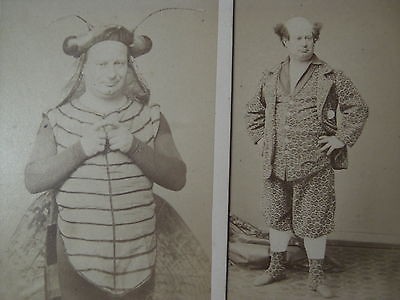Kurt Gänzl
The Encyclopedia of the Musical Theatre
1 January, 2001
In 1847 the young comedian known as Désiré asked Hervé for a two-handed musical sketch to play at his benefit. Since Désiré (Aimable Courtecuisse, b Lille, 29 September 1823) was short and plump and Hervé tall and gangling, the author selected the subject of Don Quixote, wrote a zany burlesque of Cervantes’ tale for the two of them to play together, and he illustrated it with original music rather than the borrowed tunes usual in such pieces. The two performers made a great success of their saynète and it was subsequently taken up by Adolphe Adam and played at his Théâtre Lyrique in 1848. Don Quichotte et Sancho Pança is quoted in most histories which like to try to put a finger on the first this and the first that as being the first opérette of the modern era.

“La Ronde de Sancho Pança” from Hervé’s “Don Quichotte.” (Photo: Palazzetto Bru Zane)
Désiré subsequently became a star comedian in opéra-bouffe at Hervé’s Folies-Nouvelles and Offenbach’s Bouffes-Parisiens and he created comic rôles in many of Offenbach’s works, large and small, decorating them with the improvisations which were his trademark.

Portrait of Désiré (Amable Courtecuisse) taken between 1870 and 1890. (Photo: Musée Carnavalet, Histoire de Paris)
Amongst the rôles he introduced were Dig-Dig in La Chatte metamorphosée en femme, Pan in Daphnis et Chloë, Fortunio in La Chanson de Fortunio, M Choufleuri in M Choufleuri restera chez lui le …, Cristoval in Les Bavards, Bertolucci in Il Signor Fagotto, Cabochon in Jeanne qui pleure et Jean qui rit, Fritzchen in Lischen et Fritzchen, the title-rôle in Vent du soir, Pigeonneau in Une Demoiselle en loterie, Mardi Gras in Le Carnaval des revues, Madame Madou in Mesdames de la Halle, Signor Gorja in Les Vivandières de la grande armée, Ragotin in Le Roman comique, Villebriquin in L’Amour chanteur, Robin in Le Soldat magicien, Jol-Hiddin in Les Géorgiennes, Dunanan père in Le Voyage de MM Dunanan, Veautendon in Les Bergers, Raphaël in La Diva, Balabrelock in Boule de neige and, above all, the original Jupiter of Orphée aux enfers (1858), the Golo of Geneviève de Brabant (1859), the Cornarino Cornarini of Le Pont des soupirs (1861) and the Cabriolo of La Princesse de Trébizonde (1869).

Désiré cross-dressed as Madame Madou in Offenbachs “Mesdames de la Halle.”
Amongst the rôles which he created in works by other writers were the Marquis de Criquebouef in Delibes’ L’Omelette à la Follembuche and Ducornet in his L’Écossais de Chatou and, having moved on in turn to the Variétés, the Palais-Royal and the short-lived Athenée, the rôle of the tubby mandarin Tien-Tien (paired with the skinny Léonce as Ka-o-lin) in Lecocq’s first major work, Fleur de thé (1868).
He also played in Lecocq’s L’Amour et son carquois, created Madopolam in his Le Rajah de Mysore, and Chicorat in his Le Testament de M Crac (1871), and introduced the principal comic rôle of the judge, Raab, in Vasseur’s hugely successful La Timbale d’argent. In 1872 he appeared at the Bouffes-Parisiens in Le Docteur Rose (Dr Capsulo) and in 1873 alongside Judic in Vasseur’s La Petite Reine (Pastello) in one of his last new rôles before his death later that same year.

Désiré in his most famous role, as Jupiter in “Orphée aux enfers” in 1858, dressed up as a fly.
The same name was later assumed by another French musical comedy actor, who appeared from the 1880s in such pieces as Boccace (1882, Orlando), Jeanne, Jeannette et Jeanneton, Ali Baba (1889, Zizi), Miss Helyett, Le Cadeau de noces, Le Roi Dagobert, La Fille de Madame Angot (Larivaudière in the Opéra-Comique performance), La Divorcée, Les Transatlantiques, Les Cloches de Corneville (Bailli), Les 28 Jours de Clairette (Capitaine), Madame Boniface (Jacquot), Mam’zelle Nitouche (Château-Gibus), Rip (Nick Vedder) etc.
He died in Asnières, in September 1873.
